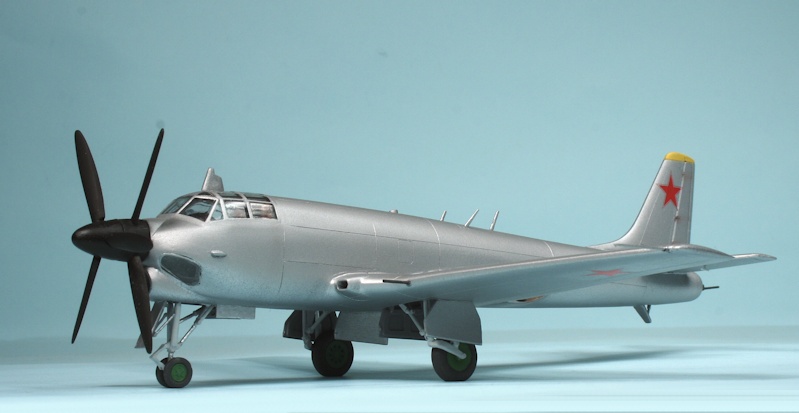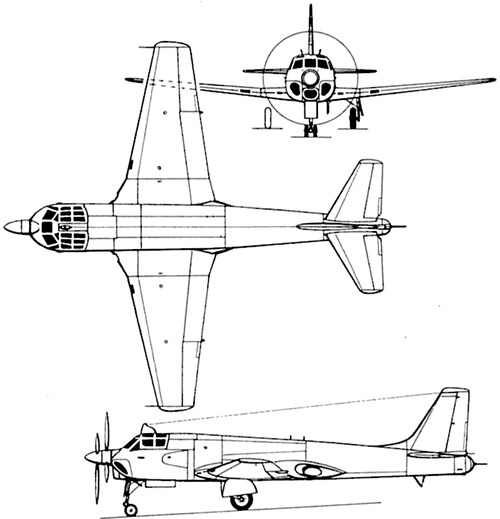- Yes
- No
Hello, everyone. Today, I will be redoing my 1st ever suggestion thread, since it’s a victim of the… “re-arrangement” of the suggestion forums’ rules.
This one covers a rather rare, obscure plane known as the Tupolev Tu-91.
SHORT DESCRIPTION
The Tupolev Tu-91, known to NATO by the reporting name 'Boot’, was a carrier-capable attack aircraft designed and built by the Tupolev OKB after the Second World War. Only one prototype was built before the cancellation of the project.
HISTORY
At the end of the Second World War, the USSR sought an aggressive expansion of its navy in order to counter US naval superiority. This program included building new warships and aircraft carriers- and to equip said CVs with strike capabilities it was required to design a new plane. This task fell to Tupolev, who responded by asking two of his teams to prepare design proposals. One of the proposals was Project 509 (1950, 9th Project), essentially a Tu-14T with arrestor hooks, JATO boosters, and folding wings (in short, a navalised Tu-14T). Unfortunately, the jet-engined Tu-14T burned far too much fuel for it to have enough range for CV operations, so the idea didn’t go through. The second proposal is the focus of this thread- the Tu-91.
Around this time, the Kuznetsov TV-2 turboprop had finished testing on the TU-4LL flying laboratory. The turboprop was a promising development; faster than a piston-powered engine but less fuel-thirsty than a turbojet engine. Plus, the Royal Navy had already begun operating the Westland Wyvern and was developing the Fairey Gannet, while the USN was trialing the A2D Skyshark- both of them turboprop-engined carrier-capable planes like the Tu-91 was to be.
Chief Designer Vladimir Chizhevsky then designed a two-seater, low-wing straight-winged monoplane, with the engine at the middle of the fuselage (between the cockpit and rear turret) driving a long propeller shaft towards the front, in turn driving two contra-rotating three-bladed propellers. The prototype was finished at the tail end of 1953, and afterwards it was brought by road, disassembled, to Tupolev’s hangar. During this period, one of the workers gave the Tu-91 the nickname of “Bychek”, after a ray-finned goby fish, because it appeared to have eyes on top of its head; this name stuck afterwards, and Tupolev personnel still alive today (those that worked at the time period, obviously), remember this plane as such.
Unfortunately for the naval expansion program, Stalin died in 1953, and the fleet expansion plan was cut back (Kruschev was rather technophilic and missile/nuke-obsessed; as a result, he didn’t like proposals for large ships on the basis that they were floating targets for missiles) this meant that they no longer needed a carrier-borne attack craft. Fortunately, VMF officers still saw the need for attack craft, and asked Tupolev to design a ground-based attack craft. The Tu-91 already fit the bill nicely, and all they really needed to do was take off the unecessary arrestor hook and folding wings.
After everything was said and done, it was tested, with pilot Dmitri Ziuzin at the controls and Konstantin Malkhasian as his navigator. Taxiing trials went well, and official flight commenced on 17 May 1955. It then undertook factory and state tests at the NII VVS (State Commission at the Scientific and Research Institute of the Air Force), which it passed with flying colors, and impressed those present enough that production was approved. Only the leaders needed to give the approval.
Unfortunately, a small mistake with getting Kruschev’s approval doomed the plane to nothing more than a prototype. In 1956, the aircraft was showed to a group of party leaders, including new General Secretary, Nikita Kruschev. Among all the gleaming examples of Soviet power and speed, was this straight-winged, odd-looking attack plane. When Kruschev asked what this oddball plane is, the naval officer attending the Bychek, awed by Kruschev addressing him, made the mistake of saying that “It could do the job of a cruiser”, instead of “it could deliver firepower equal to or greater than a heavy cruiser”. Kruschev was amused at the answer, and asked back “So why do we need cruisers then?”.
The later wars the Soviet Union got into in the 60s proved that the Bychek could have been useful in its intended role, and it’s legacy as ground-attack aircraft lives on in jet-powered aircraft like the Su-25 “Frogfoot” or MiG-27 “Flogger-D/J” (though the Tu-91 has no relation to either), even though neither of them can operate from carriers (unlike the earlier, navalised Tu-91) and were ground-based instead (like the later, non-navalised Tu-91 configuration).
IN WAR THUNDER
Due to it’s unique nature and status as a one-off prototype, the Tu-91 is better slated to be a premium plane, either purchased or event. If it is implemented as a tech tree plane, the best fit for its placement would be at the tail end of the Rank IV attackers, right after the last Su-6 but before the IL-28. It would be rather odd, being a Tupolev attacker in the midst of Ilyushin and Sukhoi attackers, but that’s the best fit I can do.
In my opinion this is a Rank IV aircraft, as it is a post-war aircraft with rather impressive performance; plus, the two turboprops in the game (Wyvern and Skyshark) are both Rank IV, so the Tu-91 should stand there as a compatriot.
As for BR, while I am normally not good with this aspect, I think a fitting BR range would be 5.7-6.3, with my choice of BR being 6.0. It is, on paper, nowhere near as capable as a Skyshark, since it has two cannons less and cannot carry as much ordnance (the Skyshark can carry 2.5t of ordnance, 1t more than this plane), so it does not deserve anywhere near the 6.7-7.0 rating, especially since it will be clobbered by the jets that inhabit those BRs (at 5.7-6.3, the Tu-91 will only face jets on occasion, whereas any higher and it will be jet food).
The Tu-91 should be in it’s Naval configuration (i.e with working arrestor hook); the land version of the Tu-91 is not preferable as the Soviets don’t really need a land-based attack aircraft around the BR range- the IL-10 and the Su-6 families.
SPECIFICATIONS
Source: The Osprey Encyclopedia of Russian Aircraft, 1875–1995, Gunston, Page 424.
- Crew: 2 (pilot and observer)
- Length: 17.7 m (58 ft 1 in)
- Wingspan: 16.4 m (53 ft 10 in)
- Height: 5.06 m (16 ft 7 in)
- Empty weight: 8,000 kg (17,637 lb)
- Max takeoff weight: 14,400 kg (31,747 lb)
- Powerplant: 1 × Kuznetsov TV-2m turboprop engine, 5,709 kW (7,656 hp)
- Propellers: 6-bladed contra-rotating propeller
Performance
- Maximum speed: 800 km/h (500 mph, 430 kn)
- Cruise speed: 250–300 km/h (160–190 mph, 130–160 kn)
- Range: 2,350 km (1,460 mi, 1,270 nmi)
- Service ceiling: 11,000 m (36,000 ft)
Armament
-
Guns:
-
2 × 23 mm (0.906 in) NR-23 with 100 rounds each in wing roots
-
2 × 23 mm (0.906 in) NR-23 cannon in DK-15 remotely controlled tail turret
-
Bombs: up to 1,500 kg (3,306.9 lb) of bombs/rockets
-
Torpedoes: 1x torpedo
SOURCES
- https://books.google.co.id/books?id=fOC7Ii5SgZUC&pg=PA113&lpg=PA113&dq=Tu-91&source=bl&ots=EzA6A7EM4Z&sig=ACfU3U008xRHR5vFr4orsOHhZAgLn9J6oQ&hl=en&sa=X&ved=2ahUKEwja8frXxfzpAhX57HMBHaAjDjg4ChDoATAOegQIChAB#v=onepage&q=Tu-91&f=false (Tupolev, The Man and His Aircraft, page 111-112
- https://books.google.co.id/books?id=PY8gAQAAIAAJ&q=Tupolev+Tu-91&dq=Tupolev+Tu-91&hl=en&sa=X&ved=0ahUKEwj-gs_81PzpAhXEe30KHfaeBIkQ6AEIUTAF (OKB Tupolev, the Design Bureau and it’s Aircraft).
- TU-91 Bychok / Boot
PICTURES
A picture of the Tu-91, taken from Tupolev, The Man And His Aircaft. It definitely is an ugly plane, resembling a Do 335 with a rear turret in place of the engine and a turboprop engine powering a 6-bladed contra-rotrating propeller (3 blades on each propeller “set”).
A 1:72 scale model of the Tu-91. For an obscure plane, there are quite a lot of model kits for this plane. Maybe it’s the appearance?
A paper-plan of the Tu-91.


